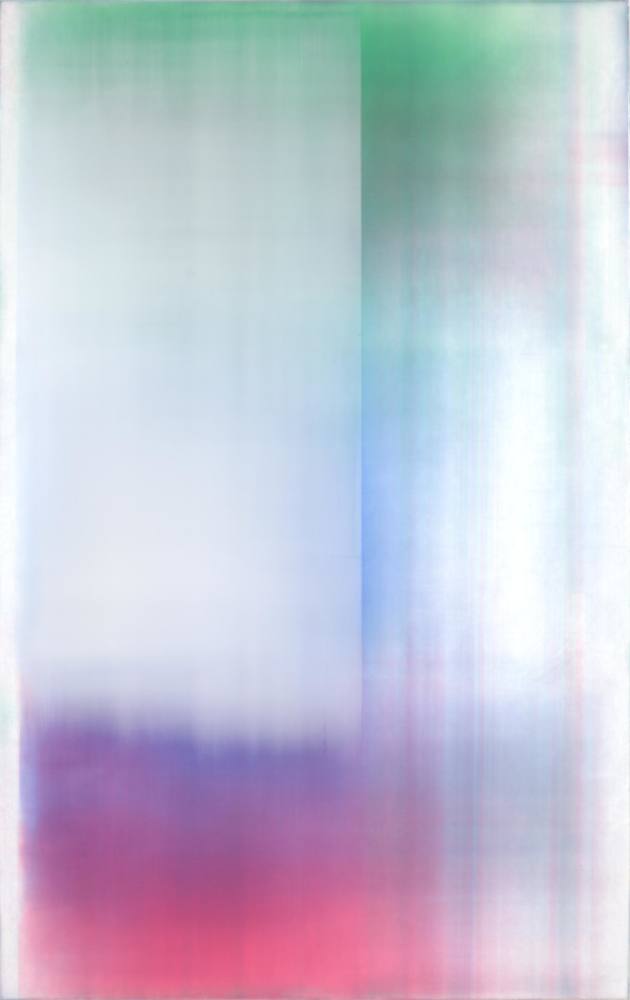Prudencio Irazabal
1954, Puentelarrá / Álava, Spain
Lives and works in Madrid and New York
Prudencio Irazabal completed his studies in Fine Arts at the Universidad de Sevilla and later at the Universidad de Barcelona in 1980. He was the recipient of a grant from the Diputación de Guipúzcoa in order to further his academic career at Columbia University. He moved to New York in 1986 where he lived and worked for the following two decades.
His work stems from an analysis on the origin of painting and a reflection on the abstract currents that emerged from mid 20th century art. These origins would lead Irazabal to initiate what he would later coin as an epistemological approximation to stratification. In the mid 90’s, through the use of microscopic photographs of his own works, he began to transform abstract chromatic ideas into blocks of layered paint that were initially treated as sculptural objects and would later be integrated into the original work. This generated a dense accumulation of material that was clearly visible from its sides. The chromaticism of this mass of paint was subsequently reunited with the top of the smooth surface and subtly nuanced through the extension of thin translucent layers of an uneven thickness.
The perversion of the premises of procedural art through the appropriation of diagrams reminiscent of archeology and geology gave way to new, more expansive and vibrant fields of color that project an interior light which reminds us of a screen, but was achieved through the artist’s very precise attention to the specificity of the materials he used; something he has done since the turn of the last century. Irazabal’s recent works continue to refer to the illusory space on the surface of the physical dimension through stratigraphic sequences that tend to be inferred rather than shown. The indetermination of contours and shapes and the enigma of the location of each color, impossible to decipher due to their translucent nature, confront the opacity of the pictorial medium through the mechanism of transparency, in other words through the power of light.
After his first exhibitions in Spain during the 80’s, his work has had a strong presence both in the United States and in Europe including some of his most relevant individual shows in New York (Jack Shainman Gallery, 1995, 1997, 2001, 2004), Los Angeles (1990, 1992) and San Francisco (2002), and those hosted at Sala Rekalde (Bilbao, 1994); Palacio de los Condes de Gabia (Granada, 2002); Artium, Centro-Museo Vasco de Arte Contemporáneo de Vitória –Gasteiz (2005) and others in Stockholm, Munich and Berlin. In 2011, he was commissioned a piece for the Church of Iesú in San Sebastian, a building designed by architect Rafael Moneo. From 2004, his works have regularly been on display at Galería Helga de Alvear in Madrid. Likewise, he has participated in the exhibitions Art and Space and The Line of Wit, both at the Guggenheim Museum in Bilbao (2017 and 2021).
BIBLIOGRAPHY: Barry Scwhwabsky and Domenick Ammirati, Prudencio Irazabal, El hijo del cristalero / The Glassmaker’s Son. Granada, Diputación de Granada, 2002; Bill Arning, Rufo Criado and Javier González de Durana, Prudencio Irazabal: Highlights. Vitoria and Burgos, Artium and CAB, 2005; Bill Arning, Guggenheim Bilbao Museum Collection. Bilbao, 2009; Aurora García, Prudencio Irazabal. Rizziero Arte, Pescara 2012.

Untitled #6E1, 2022. Acrylic on canvas. 200 x 150 cm

Untitled #1A3, 2016. Acrylic on canvas. 73 x 60 cm

Untitled #1A5, 2016. Acrylic on canvas. 73 x 60 cm

Untitled #11K, 2015. Acrylic on canvas. 220 x 177 cm

Untitled 23W, 2014. Acrylic on canvas. 88 x 150 cm
Exhibitions
Publications

Omnia Pervia
Kerber
Bielefeld, 2013
Textos de Ulrike Schick
Inglés, Alemán
56 p
32 x 23 cm
ISBN 978-3-866786-91-2

Highlights
Artium~Centro Museo Vasco de Arte Contemporáneo & CAB~Centro de Arte Caja Burgos
Vitoria & Burgos, 2005
Textos de Bill Arning, Rufo Criado, Javier González de Durana
Español, Inglés
97 p
28 x 22 cm
ISBN 978-8-493423-47-6

El hijo del cristalero
Centro José Guerrero
Granada, 2002
Textos de Domenick Ammirati, Prudencio Irazabal, Barry Schwabsky
Español, Inglés
104 p
27 x 24 cm
ISBN 978-8-478073-20-7


